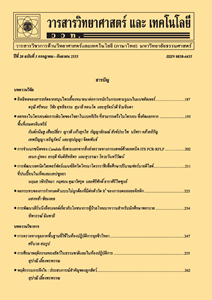ลักษณะเชิงโมเลกุลของยีนกำหนดรหัสโปรตีน APETALA2 ที่ตอบสนองต่อช่วงแสงในข้าว (Oryza sativa L.) ที่ไวและไม่ไวต่อช่วงแสง
Main Article Content
Abstract
บทคัดย่อ
การออกดอกเป็นลักษณะหนึ่งที่สำคัญของพืชเศรษฐกิจ โดยยีน APETELA2 (AP2) จัดเป็นยีนหลักที่มีบทบาทในการควบคุมการออกดอกที่ตอบสนองต่อช่วงแสงในข้าว การวิจัยครั้งนี้จึงมีวัตถุประสงค์เพื่อแยกและตรวจสอบลักษณะของยีนกำหนดรหัสโปรตีน AP2 แล้วเปรียบเทียบระหว่างข้าวที่ไวแสงและไม่ไวต่อช่วงแสง จากการโคลนบริเวณที่กำหนดรหัสโปรตีนจากจีโนมของข้าวที่ไวต่อช่วงแสง (ขาวดอกมะลิ 105 และเหลืองใหญ่ 148) และที่ไม่ไวต่อช่วงแสง (กข 7 และสุพรรณบุรี 1) ด้วยเทคนิค PCR แล้ววิเคราะห์ลำดับนิวคลีโอไทด์ พบว่ายีน AP2 จากข้าวทั้ง 4 พันธุ์ มีความเหมือนกับยีน AP2 ของพืชชนิดอื่นในฐานข้อมูล โดยเป็นบริเวณที่กำหนดรหัส 825 คู่เบส เป็นโปรตีนที่มีขนาด 274 กรดอะมิโน และพบโดเมน AP2 อยู่ภายในสายพอลิเพปไทด์ เมื่อเปรียบเทียบลำดับกรดอะมิโนภายในโดเมนระหว่างข้าวทั้ง 4 พันธุ์ พบความผันแปรของลำดับกรดอะมิโนภายในโดเมน โดยความผันแปรที่ตำแหน่งกรดอะมิโน 173 มีความจำเพาะต่อข้าวที่ไวต่อช่วงแสง คือ อะลานีน ซึ่งเป็นกรดอะมิโนที่ไม่มีขั้วและไม่ไวในการเกิดปฏิกิริยา แต่ในข้าวที่ไม่ไวต่อช่วงแสงนั้นเป็นทรีโอนีนซึ่งเป็นกรดอะมิโนที่มีขั้วและมีความไวในการเข้าทำปฏิกิริยากับโปรตีนอื่น จึงวิเคราะห์ความผันแปรของกรดอะมิโนต่อโครงสร้างและการทำงานของโปรตีน โดยนำลำดับกรดอะมิโนของโปรตีน AP2 จากข้าวที่ไวต่อช่วงแสง (ขาวดอกมะลิ 105) และไม่ไวต่อช่วงแสง (กข 7) มาทำนายโครงสร้างโปรตีนสามมิติ พบว่าบริเวณที่ผันแปรนั้น (173) อยู่ภายในเกลียวแอลฟาที่ทำหน้าที่เป็น active site ซึ่งแสดงให้เห็นว่าความผันแปรที่เกิดขึ้นทำให้โปรตีน AP2 มีความไวในการทำปฏิกิริยากับโปรตีนอื่นที่ต่างกันโดยข้าวที่ไม่ไวต่อช่วงแสงมีความไวในการทำปฏิกิริยาที่สูงกว่า นอกจากนี้ยังได้นำลำดับกรดอะมิโนของสายพอลิเพปไทด์ AP2 ของข้าวทั้ง 4 พันธุ์ มาสร้าง phylogenetic tree พบว่าข้าวที่ไม่ไวต่อช่วงแสง คือ กข 7 และสุพรรณบุรี 1 ถูกจัดไว้ในกลุ่มเดียวกัน โดยแยกออกจากกลุ่มข้าวไม่ไวต่อช่วงแสง คือ ขาวดอกมะลิ105 และเหลืองใหญ่ 148 อย่างชัดเจน ซึ่งชี้ให้เห็นว่าโปรตีน AP2 น่าจะมีวิวัฒนาการที่แยกออกจากกันระหว่างข้าวที่ไวและไม่ไวต่อช่วงแสง เมื่อตรวจสอบการแสดงออกของยีน AP2 ในการตอบสนองต่อช่วงแสง โดยเปรียบเทียบระหว่างขาวดอกมะลิ 105 และ กข 7 ในสภาวะช่วงแสงสั้น (SD) และช่วงแสงยาว (LD) ด้วยวิธี quantitative real-time PCR พบว่าการแสดงออกของยีน AP2 นั้นมีการตอบสนองต่อช่วงแสงทั้งในข้าวที่ไวต่อช่วงแสง คือ ขาวดอกมะลิ 105 และไม่ไวต่อช่วงแสง คือ กข 7 โดยมีแสดงออกสูงในสภาวะช่วงแสงยาว และมีการแสดงออกต่ำในสภาวะช่วงแสงสั้น ซึ่งชี้ให้เห็นว่าการแสดงออกของยีน AP2 ในระดับถอดรหัสเพื่อตอบสนองต่อช่วงแสงของข้าวทั้ง 2 ชนิด นั้นเหมือนกัน แต่โปรตีนที่ได้จากการแปลรหัสมีความไวในการทำงานต่างกัน ซึ่งเป็นรายงานฉบับแรกที่ศึกษาและเปรียบเทียบโปรตีน AP2 ระหว่างข้าวที่ไวและไม่ไวต่อช่วงแสง โดยผลการวิจัยที่ได้ในครั้งนี้สามารถนำไปใช้เป็นข้อมูลในการอธิบายการควบคุมการออกดอกในข้าวทั้งที่ไวและไม่ไวต่อช่วงแสงต่อไป
คำสำคัญ : ข้าว; ไวต่อช่วงแสง; ยีนตอบสนองต่อช่วงแสง; โปรตีน APETALA2
Abstract
Flowering transition is one of the important trait of crop plant. APETELA2 (AP2) is a key gene, which plays a crucial role in the regulation of flowering transition in response to photoperiod in rice. This research aimed to isolate and to characterize gene encoding AP2 protein by comparing between photoperiod sensitive and insensitive rice. The complete coding region was cloned from genomic DNA of both photoperiod sensitive (KDML105 and Leuang Yai 148) and insensitive (RD 7 and Supanburi 1) rice cultivars using PCR technique. Those of four nucleotide sequences were analyzed. The nucleotide sequences showed highly homologous to genes encoding AP2 protein of other plants. This gene was consisted of 825 bp open reading frame (ORF) encoded 274 amino acids. The AP2 domain were detected and compared among four cultivars. Variation of amino acid sequence was found in AP2 domain, which showed the specific site to photoperiod sensitive and insensitive rice at position 173, nonpolar amino acid, alanine conversion to polar amino acid, threonine, respectively. Three dimension structure of protein was constructed to detect the effect of amino acid substitution on the structure and function. Alanine threonine substitution was found in a helix active site, indicating that AP2 of photoperiod insensitive rice is more reactive than AP2 of photoperiod sensitive rice. Moreover, those of four amino acid sequence were used to construct phylogenetic tree. It showed that photoperiod insensitive rice, RD7 and SP1 were grouped and separated from photoperiod sensitive rice, KDML105 and Leuang Yai 148, indicating the separated evolution of AP2 protein between photoperiod sensitive and insensitive rice. In addition, the expression of AP2 gene in response to photoperiod was further analyzed by comparing between KDML105 and RD7 under short day (SD) and long day (LD) using quantitative real-time PCR. The expression of AP2 of both KDML105 and RD7 responded to photoperiod. It was high in LD and low in SD. This result showed that AP2 transcription in response to photoperiod was not different between photoperiod sensitive and insensitive rice. However, the active function of its individual protein probably has some difference. This is the first report of AP2 protein in comparison between photoperiod sensitive and insensitive rice, which can be used to elucidate molecular regulation of flowering transition in photoperiod sensitive and insensitive rice.
Keywords: rice; photoperiod sensitivity; photoperiod responsive gene; APETALA 2 protein


